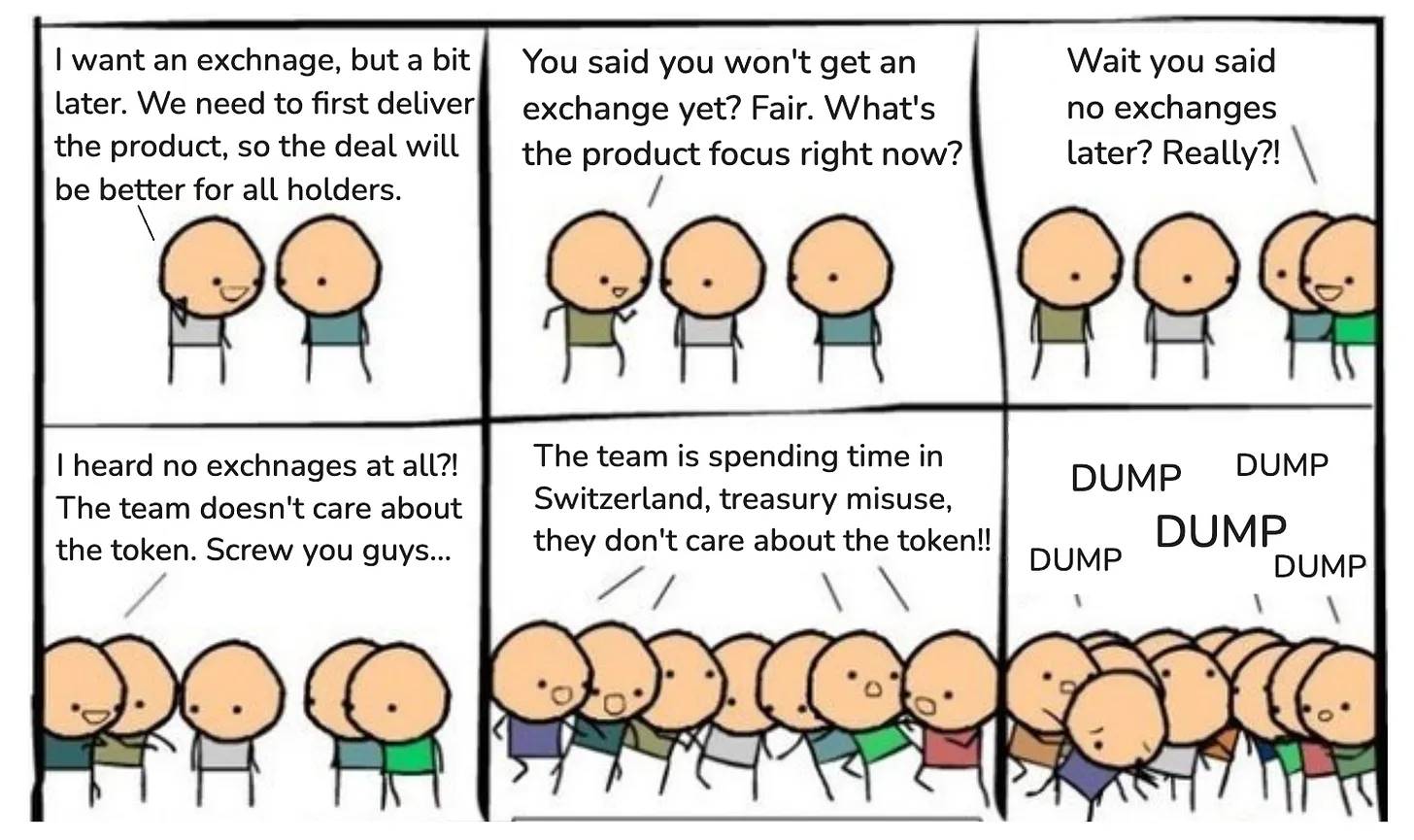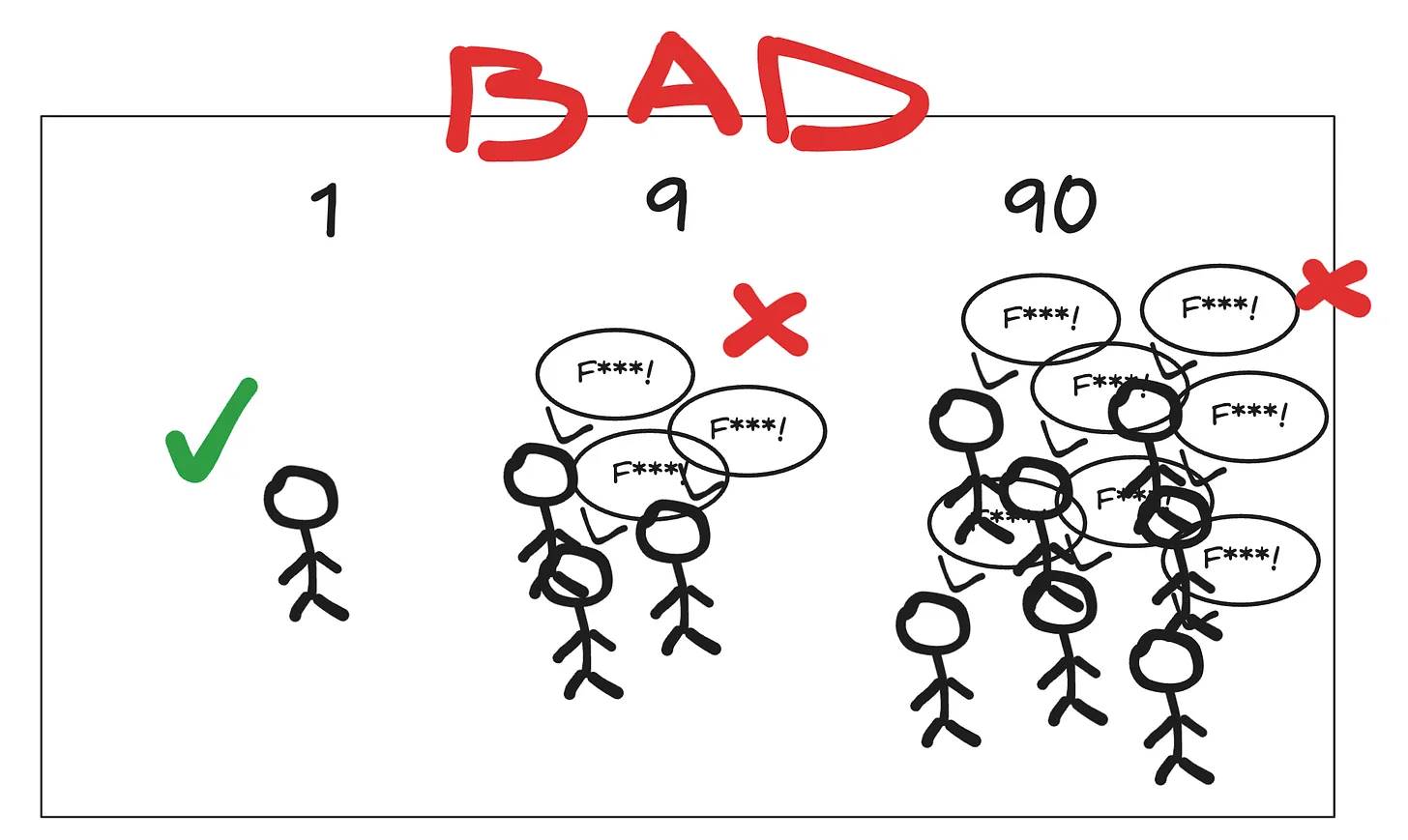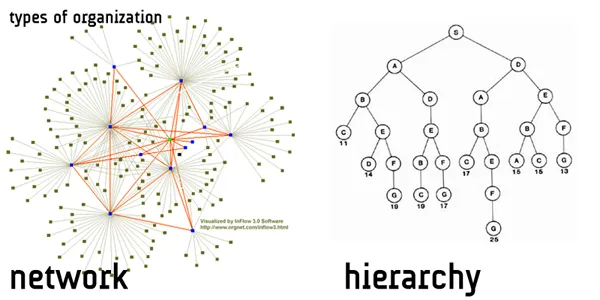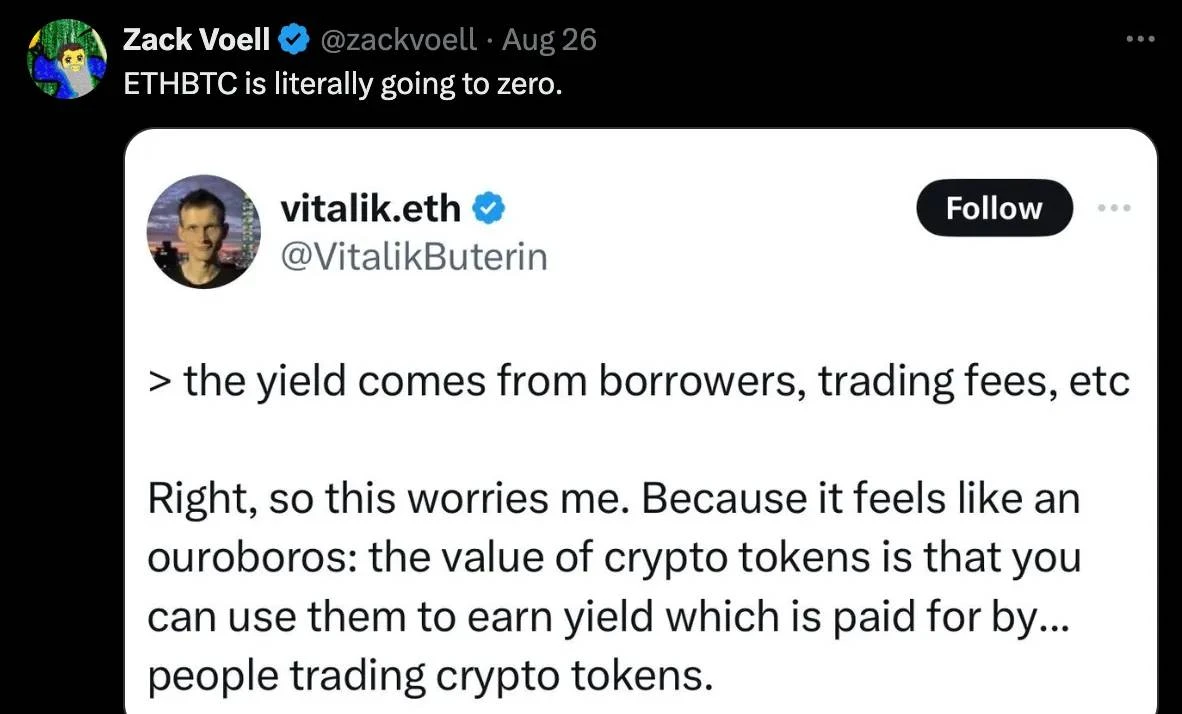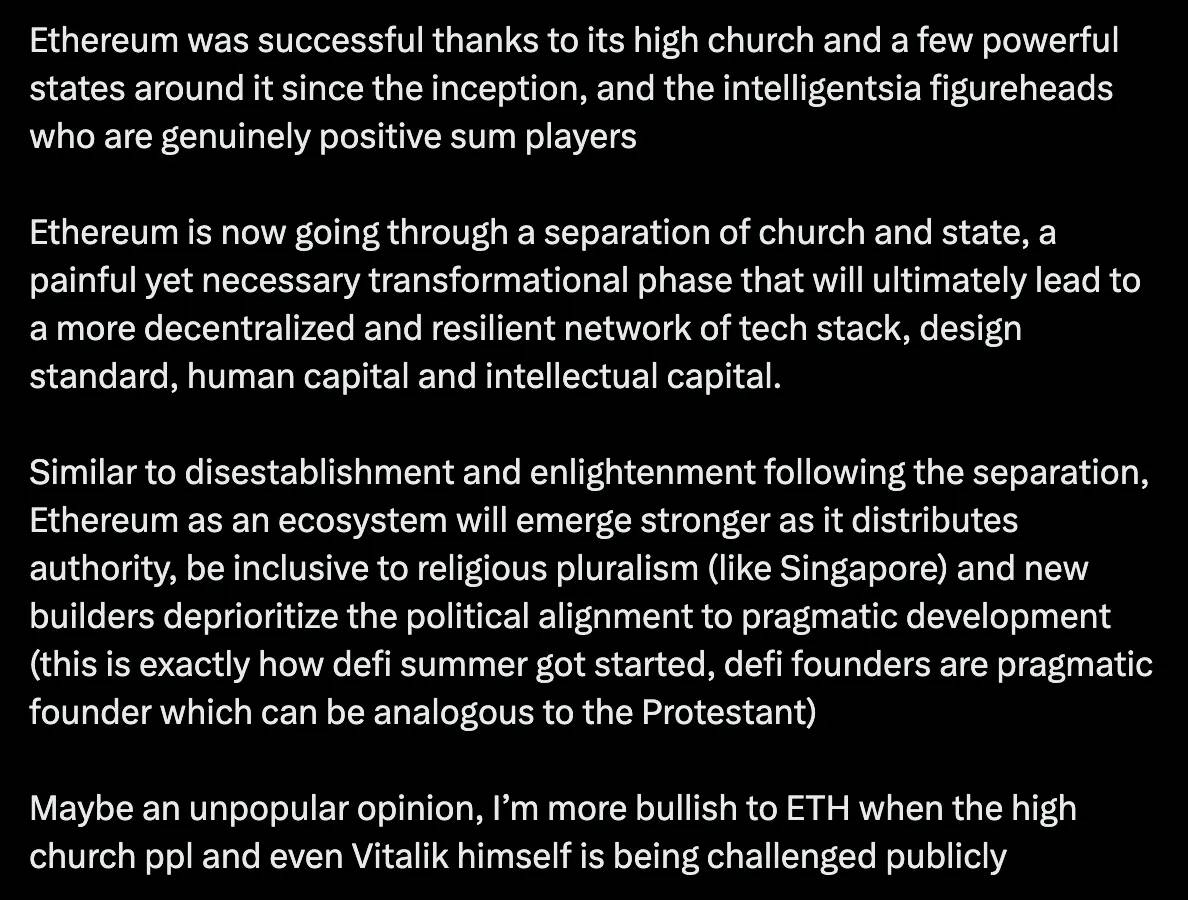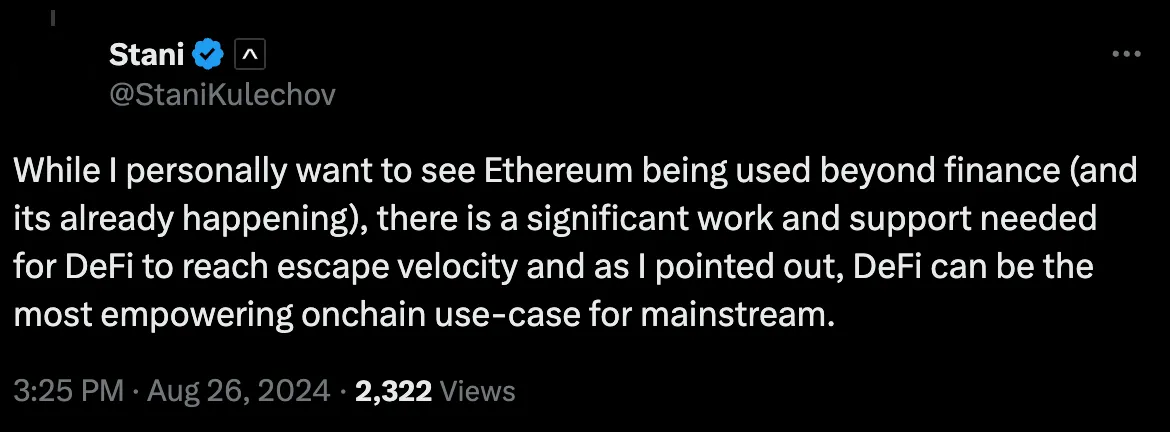Vitalik’s thoughts on the DeFi debate: The communication gap between 1% of developers and 90% of traders
Original author: ivangbi
Original translation: TechFlow
This post is divided into three parts:
1. The importance of proper communication, both with regular users and partners. The introduction uses a general example and sets the context for the topic.
2. 1-9-90: The second part discusses the 1-9-90 guidelines and my interpretation of them. This can be widely applied to any community self-startup.
3. The difficulty of maintaining consistent communication in large groups, and the potential situation where it may no longer be needed at a later stage (today’s Ethereum). You can think of the third section as a compelling overview of the Ethereum debates of the past week, which are part of the same question. Does 1-9-90 apply to Ethereum? is one of the questions discussed in this section.
1. Introduction: Common misunderstandings between developers and token holders
Coin holders: “When will it be listed on the exchange? When will the coin be listed?”
Developer: “We are focusing on the product right now, not this.”
Token holders: “You don’t care about the community, screw you!”
Developer: You are just a short-term speculator, get lost!
You’ve seen this conversation before, right? This is what every project’s Discord, Telegram, and Twitter chats look like. I can guarantee you that both sides in this conversation are unhappy with each other. The holders see the developers as regular people demanding a quick pump and dump. Meanwhile, the developers see the holders as elitist assholes building castles in the air.
Both are right and wrong. They just cant communicate. They speak different languages. Coin holders only care about the value of their assets, but do you think developers dont care? Developers care too. As for whether developers cant handle the business side of things – thats another question, lets not talk about it for now.
PS: Please note that I am not idolizing either group because they are both right and wrong. It is a bad idea to lean towards either side, you need to see the middle.
1.2 Quick response strategies to prevent the spread of negative emotions
-
Coin holders: “When will it be listed on the exchange? When will the coin be listed?”
-
Response: Cant respond publicly to this yet, but its certainly an important question. You can join the discussion here. In the meantime, were working on some cool product announcements, so please voice your opinions in this thread!
This holder may not participate further, but they also won’t instigate trouble. Their immediate need for a response is met, and eventually they’re likely to go there and contribute their opinion. Win-win!
Experienced people will understand that they are getting a fairly superficial response, so you cant make it sound too much like a chatbot. You need to direct people to some relevant and helpful context so that you dont come across as if you are talking to a child. Again, simply pushing back may work once or twice: it is a temporary solution until you have a real answer. Repeated use of pushing back will eventually become counterproductive. This strategy will also not work if the accumulated anger reaches a peak. In this case, you must give a real and detailed response or accept a temporary decline.
In WEB2, there are teams dealing with FUD (Fear, Uncertainty and Doubt) prevention on social media. In restaurants, there are staff trained to handle even the angriest and drunkest customers. Why do you think it’s different here?
Conceptually, no developer has any obligations to the coin holders (I morally think they do, but that’s another topic), however, no one has any recognition or monetary obligations to the developers.
You two, stop being so cocky.
1.3 Structural solutions to fundamental problems
Their goals are somewhat the same: token appreciation. However, their paths to achieving their goals are different, and therefore their timelines are different. Developers need the value of the project to be high in order to have enough liquidity to exit their investment. Also, some developers, believe it or not, do want to build something cool! Holders, on the other hand, only need a $100,000 order book to sell. So while their incentives are generally aligned, they work in different timeframes. Thats obvious, I know.
However, the best way their goals can be achieved is collaboratively. Developers need lots of holders, and lots of holders need good developers to build. They cant coexist, because if they tried… youd end up with the current market. 90% of the people are gambling PvP with Meme tokens, and 1% are elitist hypocrites building castles in the air and vacationing in Switzerland for the summer, right?!
PS: There are indeed cases where developers make false promises, or holders become extremely negative because the market is all red. In these cases, there is nothing that can be done on both sides. You need to unite and align the vision with your core supporters, and if you have to refresh the vision, hold your chin up and work hard. If you can produce good results without dying, you will become stronger. Speaking out only works in the case of complete collapse.
So, what exactly is 1-9-90 and what does it have to do with all this? I didn’t come up with this concept myself, and there’s even a Wikipedia page about it. I’m not sure if my interpretation matches Wikipedia’s meaning, but I’ve found it works in practice over the years. No matter where.
2. 1-9-90 Community Building
To simplify understanding in the context of cryptocurrency, you can think of it as:
-
1% are the developers, builders, teams, and creators.
-
9% are writers, funds, researchers, and angel investors who are watching the space with enthusiasm and making some comments. Not really a team, but not newbies passing through either.
-
90% are random traders and speculators who actually never read the documentation. They only read the headlines, buy and sell tokens, and hold cryptocurrencies – but they dont care about research issues. Just speculators and traders who like yellow push. They are not stupid, they just dont want to marry any investment. For them, fundamentals usually dont exist, they just want charts.
All of these groups are important. In isolation, they will all slowly die.
Speculation fuels capital markets and investment, which in turn provides developers with the resources to build, which in turn fuels the fundamentals for pure speculation, and so on. It operates like a living organism. Cut off a part of it, and it withers.
Dont be self-righteous!
2.2 Why does 1-9-90 work?
We can’t know everything and keep up with everything. We may not like overly generalized statistics and carefully crafted content on Netflix, but we can’t live without them. If we allow multiple options for everything, our minds will explode. Especially in startups. We want others to do this work for us. Those who go rummaging through a pile of junk can find finer gems, but sometimes it’s okay to follow the crowd.
-
Why pay attention to what the 9% say? — Because these funds, researchers, and angel investors are seen as credible in many cases. They have been around for years, so they won’t succumb to cheap scam propaganda. Or at least that’s the hope. Therefore, it’s easier for traders and speculators to simply choose those assets that have the most reliable group of supporters behind them.
-
Why are 9% willing to act as filters? — Because the better they filter, the more money they can make. And they may attract better long-term followers. If you can pick out gems earlier, you can get better valuations, and it also signals to others that you are capable of being a gem hunter.
The 9% is the glue between the extremely focused 1% of developers and the 90% of traders and holders who must buy into a more refined narrative. If I were to be specific about what the 9% does, I would say it is organic marketing and some warm referral business. Essentially injecting prestige and flavor into early, unknown projects.
2.3 What the 1-9-90 stage looks like
These three don’t usually align at the same time, and only in bull markets. The goal is to always have 2/3 aligned, which is doable. 1% and 90% aligned is unlikely by definition, because the glue that delivers news to the 90% is the 9%. Therefore, you must always start with 1% + 9% and then build on that.
An exception is 1% + 90% because you are building something completely easy to use for the 90%. This would be meme tokens, click games on Telegram, and similar phenomena. In these cases, the 9% is not needed in the launch phase. However, after these things go live, they need some sustainable alignment, but this alignment is not needed in the launch phase because everything happens on the hype.
This would be a typical venture capital project model, team, angel investors and community holders. A team (1%) starts a project, then (9%) drives it further and increases its visibility, and then a large number of traders and holders (90%) follow the project narrative and participate in it.
1. 1% of developers start working on an idea and start making something.
2. They consult with friends, angel investors, capital allocators, researchers, etc. These are the 9% who are excited about some idea.
Then, for some reason, a lot of the ideas that the 1% and 9% participants focused on somehow ended up making their way into the 90%.
This is the general recipe and direction for all companies. This does not guarantee success, but this approach usually achieves initial success. If you already have a network, the process from 0 to 1 is usually easy because they will accept and support no matter how you push it.
A bad example is Worldcoin, where despite its very strange product and token strategy (no matter how drastic and dystopian it was), many of the “9%” supported it and accepted it into their communities simply because of the founders’ network.
2.4 The lack of 9%
You generally shouldn’t take the shortcut of ‘1% + 90%’ and ignore the 9% in the middle. Because the 9% have a longer-term perspective than the 90% of regular users, and they are the foundation for the stable development of the project. If you end up with a hype-driven community without cultivating the 9%, you may be left with only the 1% in any market turmoil. This is the problem with projects that rely solely on hype. It’s a good launch strategy, but at the end of the day, you have to find your 9% or convert your 90% members into the 9%. You can’t do without evangelists and those who are willing to support you.
Remember the “fair launch” projects of 2020-2021 selling on the secondary market? Some projects launched without any public sales, just shares allocated to contributors and/or DAOs. After a few weeks or months, they needed funds to stay afloat and further develop the brand or protocol. So, they conducted over-the-counter (OTC) transactions on the secondary market. These transactions may have been at different prices, but did not change the overall operating model. In the end, although they started with a 1+90 model, they had to work hard to find that 9%.
Another reason has to do with perception. If I’m a researcher and I go into a chat group and the only content I see is giveaways and airdrops — I immediately think “this is a scam.” And I’m right most of the time. This is an overgeneralization to save time, but it works. So you generally want to keep it lean and simple, producing technical content to grow the 1% + 9% first, and then move on to a broader strategy. Otherwise, you might attract the 90%, create too much noise, and neither attract the external 9% nor convert your 90% into the 9%. Be careful!
This is especially dangerous for click tokens and quick IEO launchpads. Fortunately for these founders, most of the time these projects are built and setup like scams, so they don’t care about community building at all.
2.5 Real-life example: Ethereum conference
The most typical example of 1+9 interaction in the real world is the Ethereum conference. Many developers come here to talk with funds and angel investors who are looking for alpha, and some new ideas come out of it. Those 9% people, i.e. funds and angel investors, may love crazy dreams and ideas, but at the end of the day, they are more eager to make money than the 1%, so they need to check with the 90% how much demand there is for any given narrative currently, or how much it may be needed in the future.
The 1% + 9% can hard sell something to the 90%, but it is harder than expected. It is hard to force this. You need some fundamentals and data to support your claims: it is not always easy. You can think of Celestia as an example of a well-crafted and slightly forced market segment, valuation-wise. I am not disparaging it, they are indeed smart people, but it is not easy to push a new narrative to $10 billion+ and sustain it for months. The 90% knows nothing about DA and they certainly don’t think it is a $10 billion+ market.
Anyway, the problem comes when the 9% gets too self-absorbed. This happens when they hang out with the 1% and forget to check reality with the 90%. Then you end up with closed parties of developer elitism that no one benefits from. Its important to focus on reality, otherwise everyone suffers.
Lasting optimism and dreams are good, but pursuing them too much is not good.
2.6 How to maintain 1-9-90 consistency after the startup phase
Because nothing goes up forever, you will experience moments where consistency and belief in the future breaks down, even if you have a perfect 1+9. In those moments, you need to analyze why. Did the team stop working, or did the market just turn red? Are the developers still working, but they are building castles in the air that even the 9% cant understand?
These are some of the questions you need to check sentiment. If the team is working and the narrative is intact, then it is likely that 1+ 9 is consistent. Therefore, they need to continue building when the market is down, so that will be fine. There is nothing you can do here.
In times of crisis, you just talk to your partners, let them know some new details, and reaffirm their biases if needed. No one is fully convinced about anything new at first, but time creates strength in the brand and vision. Cultivate it first, then it will happen naturally. This can actually be applied to trading as well: when all tokens were falling during the bear market, and MATIC was the only one that was slightly rising, traders started promoting it as a “green haven for all markets”. And it was!
You cant let the 9% and the 90% get confused. That means developers face complete alienation. You need the core team to communicate with the angels and researchers, and you need the angels and researchers to know how to communicate information to the 90%. This is not some kind of pyramid, by the way, this is just the way information spreads between individuals. Its a fact.
“Actions speak louder than words” and “the best technology wins” are both true. The opposite is true when there are too many (good) bad words or when the marketing of bad technology is done very well. Humans, and therefore markets, are not rational.
2.7 Checks and Balances among Groups
-
The 1% may become too complacent with their success, becoming too elitist and overly self-centered. The more capital they acquire, the further away reality checks become, and their thinking becomes overly optimistic and comfortable.
-
9% of people: should have done their research but only knew snippets (like me). The problem is they draw too much attention to themselves and waste the founders’ time explaining things — otherwise, they could just spread false narratives and ideas. These people tend to talk a lot because for many of them, giving an opinion is their job. Can easily become fake.
-
90% of people: no problem! They take all the risk and get the least resources. Of course, their patience and ability to survive are the lowest, but that’s also because they have no golden cushion when the developer decides to go their own way and take the funds.
Now let’s apply this playbook to Ethereum…wait, maybe it’s too late?!
3. Ethereum: Vitalik vs DeFi vs Ethereum Foundation
There has been a lot of controversy and discontent within the Ethereum community over the past few days. This is not surprising; people are just confused and cant find a way to express their confusion. Theyve been working for over 3 years since the last cycle, but theres no new volume or users coming to buy their asset, so everyone is frustrated. Its just a fact. Im not suggesting reasons or solutions – thats for another article. Im just stating the status quo here.
In this debate, some people tried to have a rational discussion. For example:
-
Vitalik (1%) expressed his concerns about DeFi. Check out this tweet, its well written, theres more in that thread. He may be too focused on his own overly grandiose vision, but hes polite and provides context. He wants to think about the bigger picture, inspire others to look beyond what we see today, not be stopped by what we have, but look to the future. Thats what it means to have a vision. He doesnt need to be right all the time either, he doesnt own Ethereum.
-
The Ethereum Foundation (1%) was silent on the topic of selling for a few years, and then Aya made a somewhat insensitive response. Not because she said anything bad or wrong, but because of not reading the atmosphere because EF is far away from the problems faced by ordinary people. However, see here for more details, EF did and is still doing a lot of transparency work.
-
DeFi founders (1-9%) are confused because even though they are powerful and don’t care about external support, they also want some support, at least not to disparage finance at every step, which Vitalik did almost jokingly before. Maybe he did it too much and finally made people unhappy.
The communication barrier is what is happening. The Ethereum Foundation and the Brain developers are too focused on the future and therefore sound like they don’t care about today’s problems. Even though they do care, their thinking has gone further. This makes it difficult for the other party because they don’t have as much context about all the thinking and thought processes. What you end up with is: (The communication wall shown below)
3.2 Are there any structural problems with the 1, 9 or 90 here?
As mentioned before, any criticism is reasonable in theory, but what is the specific reason? Is it because developers are marginalized, or is it that 9% of the group is not clear about what is going on, or is it just that 90% of people are complaining about the price? This is the question we need to explore.
Let’s first look at the 1% case.
Are developers actively working on it? Yes. Are they participating in public discussions? Absolutely. Are different development teams working on different projects at the same time? Same. Are there events and hackathons to attract new developers? Yes. Is there a systematic way to solve the fragmentation problem of L2 now, especially after the scalability part is solved? Yes. So I think the 1% group is fine.
Next, lets take a quick look at the 90% case.
They know that ETH is an important asset and that the market may fall. They are confused as to why a considerable number of the 9% group are also confused. Unwarranted panic may cause real structural problems.
Finally, we look at the 9% case.
I personally think that some of those who were once part of the 9% have now become sensational traders. There is nothing wrong with that, but we can no longer treat them as the real 9%. They no longer look deep and just follow the headlines. Mistaking them for the 9% may lead you to believe that there is a structural problem. If you want to confirm this, ask the developers. If the developers think the same, then there may be some problems.
Market turmoil has turned some 9%ers into 90%. And the 1% are continuing to work!
No disrespect, but if you study L2 and conclude “fragmentation is killing ETH, done” while ignoring all the research on scalability — that’s a skills problem.
3.3 Are efforts underway or are issues being ignored?
Clearly, it’s understandable that 9% are confused. Ethereum is growing, and it’s had a L2 roadmap for years, which has led to fragmentation in its development. When you go modular, it’s normal to have issues connecting the pieces. As long as the goals (scalability, a larger platform) are valid, this is explainable.
So I understand if someone feels bearish in the short term, but making it sound like “Ethereum is dead and not working on scalability” is an intellectual lie. The 9% engaging in this narrative are just promoting their alternatives and are turning into the 90%. Watch out for those inflammatory Twitter users.
I am not protecting my assets because this post will not affect anyone. I am happy to see and accept that there are structural problems, but other than some EF member got some advisory position and EF sold some ETH, which is less than 0.1% of the total circulation – I dont see any more arguments. You can do better.
But should the 9% be taken care of anyway, as the guidelines state?
I further argue: it is no longer necessary and no longer possible.
3.4 Separation of state and church. Forget leadership? Forget the 9%.
Bitcoin and Ethereum are on the left, and all other chains are on the right. Therefore, you can’t apply the same rules to both. Progressive decentralization, my friends.
Ethereum is clearly at the network stage. At this stage, asking for alignment to the roadmap is a misunderstanding of the purpose of how things work. This doesnt mean that attempts at macro alignment are unnecessary, but they are happening ad hoc right now. If you look at the first picture, consider the main orange connection points as the main Ethereum teams: clients, large funds with research departments, interconnected protocol ecosystems, etc. As long as they can align with each other occasionally, then its fine. So ask yourself: if you dont know what the orange ones are doing, then you probably dont have deep knowledge. So this is a skills problem, not an ecosystem problem. Dont be complacent.
( See tweet for details)
All of this discussion, criticism, etc. should happen. What’s different this time is that too many previously good players have become extremely aggressive and creating chaos. Especially some of the general partners of the funds (you know who I’m talking about). Most are the ones who are pushing their own L1 garbage bets. If they think other L1s are better, support them, etc., that’s fine. However, doing so at the expense of a made-up argument is intellectual suicide. Like this:
The yield comes from borrowers, transaction fees, etc. Yes, this worries me. Because its like an Ouroboros: the value of crypto tokens is that you can earn yield on them, and those yields are paid by people who trade crypto tokens.
This isn’t the first time we’ve seen large ecosystems fall into this situation. Fragmentation, different unaligned interests, etc., are really right in front of us right now. But rather than moving toward a communist and centralized roadmap, maybe a better path is to elevate this all to a non-fragile state. Leaving aside the fancy words, none of this matters. DeFi, social, whatever it is — it doesn’t matter what Vitalik thinks, what the Ethereum Foundation thinks, or what any guru thinks.
So what to do?
1. Vitalik may be too elitist and want use cases that don’t exist yet or will never exist. People want more utility, and DeFi brings that.
2. The Ethereum Foundation could be more transparent, sure.
3. Ethereum’s narrative has become multifaceted, making it difficult for the 9% to understand a clear agenda and thus confusing.
But the answer is: it doesn’t matter.
3.5 You cant, and dont need to, align perfectly.
How many groups exist on Ethereum right now? Client teams? VC funds? Raid groups? — The answer is: a lot. When was the last time you needed approval from the Ethereum Foundation (EF) or Vitalik’s blessing to build anything that wasn’t related to the core protocol? — Never.
Contents of the picture:
I think people just want consistent transparency around fund transfers and sales to be able to disavow instances where those were falsely attributed to the Ethereum Foundation.
It would be helpful to have a full-time communications person writing about strategy and narrative in a way that the average reader can understand. So far, Ethereum’s narrative is unclear (is it sound money, or is it technology?), and what value should we place on it? Wall Street.
Im not bashing Evan, his tweet makes sense and seems sincere. Im just saying that while this is a reasonable request in general, in the case of Ethereum it cant and shouldnt be executed. However, this is my personal, subjective opinion and may not be accurate.
EF could disband tomorrow, Vitalik could go off with his yacht – it doesnt matter. Even if transparency is an issue, even if Vitalik is wrong, what does it matter? Ethereum is or should be at a stage where the core initial team no longer matters. So the following attempt to turn this into some kind of Ethereum culture problem doesnt hold water. Culture is an open level playing field, not a centralized view. Bitcoin has been through similar tests before, so this is a real test of the strength of the theory.
( See tweet for details)
In my experience and that of my crypto friends since 2017, no one has ever received any meaningful support or funding from Vitalik. He criticized ICOs during the boom and DeFi in 2020 – and thats fine. He doesnt need to be right all the time. He had to be right about building community and being a visionary in 2015, 2017, and beyond… but at this point some have formed a coalition against EF. Thats fine!
The founders of DeFi did not ask for his blessing or the support of EF. In fact, it was initially built through their objections. Yet, DeFi survives and grows, so why ask for any blessing now? One thing to note is that everything is fine as long as they dont make some core protocol changes that make DeFi less usable. For example, the gas cost of certain operations that are critical to DeFi. Basically pursuing their grand vision at the expense of DeFis usability and growth.
While I personally would like to see Ethereum used in areas beyond finance (which is already happening), there is still a lot of work and support needed in order for decentralized finance (DeFi) to grow quickly. As I have pointed out, DeFi can become the most enabling on-chain use case for the mainstream.
Well said. Letting the winners go is probably the right tech-focused approach for EF and Ethereum builders. Even if “it’s just finance”.
So, sensationalists can relax and not blow small arguments into big issues.
Ethereum’s success is due to the support of its top institutions and several powerful countries around it since its inception, as well as the intellectual leaders who have truly actively participated.
Ethereum is now undergoing the separation of church and state, a difficult but necessary phase of transition that will ultimately lead to a more decentralized and resilient network of technology stacks, design standards, and human and intellectual capital.
Similar to what happened after religious separation and the Enlightenment, Ethereum as an ecosystem will become stronger when authority is decentralized, religious diversity is tolerated (like Singapore), and new builders deprioritize political alignment and focus on pragmatic development (which is exactly how the DeFi summer started, with DeFi founders being pragmatic founders, analogous to Protestants).
Maybe it’s not a popular opinion, I am more bullish on ETH when top figures and even Vitalik himself are publicly challenged.
Another point about the diversity of opinions and teams in large networks.
3.6 Other points to consider
-
No matter what Vitalik says, people will always get angry. At a certain point, responding to angry Twitter users becomes negative unless they have legitimate criticism. But if they nitpick every word out of spite, let them be. Still, expect to read the vibe. Vitalik is pretty good at this, but not always.
-
The Ethereum Foundation does a lot of transparency, but could do more. It doesn’t matter if they don’t, since almost no one interacts with them directly. So it’s not a systemic problem they don’t need to face (9s forces this narrative to be a systemic problem). Maybe look at other players in the ecosystem that are moving fast.
-
Other foundations are spending far more than the Ethereum Foundation, and have foundation presidents running venture capital funds (Solana), and even foundations that are almost buying meme coins (Avalanche). Again, this is both good and bad, and Im not trying to say they do worse, so its okay to do bad things. No, Im just saying that the other chain pullers should probably solve their own problems before shouting.
I hope you understand the importance of proper messaging and communication. These fundamental principles extend beyond raw technology to general community building and your positioning with other partners in the industry.
As for Ethereum, I hope I convinced you that there is no more hand holding. No more leadership. No more top-down centralized roadmaps. So let people fight each other, exploit each other, and support the free market.
Also be careful who you listen to. The 9% often become the 90%. The exception is that the 90% will not lie about their intentions, while the 9% will often spread untrue or misleading information in an attempt to gain benefits through false propaganda.
This article is sourced from the internet: Vitalik’s thoughts on the DeFi debate: The communication gap between 1% of developers and 90% of traders
Related: KIP Protocol announces partnership with Moemate to help 3 million Web2 AI users enter Web3
KIP Protocol announced an important collaboration with Moemate, a leading AI Agent platform. This collaboration will leverage KIP Protocol’s purpose-built decentralized infrastructure to help Moemate’s more than 3 million users enter Web3. Moemate will serve as the flagship project of KIP Protocol’s new AI Alliance, demonstrating KIP Protocol’s ability to handle large-scale deployments and setting new standards in scalability, security, and ownership of AI interactions. The AI Agent market is growing at a compound annual growth rate (CAGR) of 40.7% and is expected to reach $51 billion by 2030. This collaboration will position KIP Protocol well in a rapidly expanding industry. KIP Protocols technology addresses key data privacy and user control issues, and is expected to transform traditional AI services and drive the transition to decentralized AI solutions across industries.…
